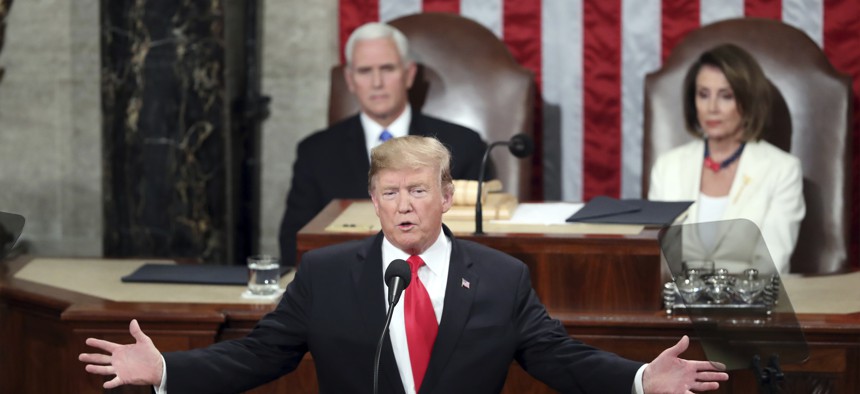Trump Short on Infrastructure Details in State of the Union

President Donald Trump delivers his State of the Union address to a joint session of Congress on Capitol Hill in Washington, as Vice President Mike Pence and Speaker of the House Nancy Pelosi, D-Calif., watch, Tuesday, Feb. 5, 2019. AP Photo/Andrew Harnik
The president said it's time to deal with ‘crumbling infrastructure,’ but delivered no concrete ideas on how to invest.
WASHINGTON — President Trump in his State of the Union address Tuesday expressed optimism Republicans and Democrats could work together on an infrastructure package, but offered no details on what his administration would support.
“Both parties should be able to unite for a great rebuilding of America’s crumbling infrastructure. I know that the Congress is eager to pass an infrastructure bill, and I am eager to work with you on legislation to deliver new and important infrastructure investment, including investments in the cutting edge industries of the future,” Trump said well into his speech. “This is not an option. This is a necessity.”
Infrastructure played a much larger role during Trump’s first State of the Union last year. But the administration’s eventual $1.5 trillion proposal, which relied on state and local governments putting up much of the dollars, along with private investment, never went anywhere.
This year, state and local government officials said before the president’s annual speech that they not only wanted him to talk about spending money on roads, airports, public transit and other projects, but offer specifics on how to proceed. “I’m going to be in the gallery tonight, and I hope that the two most spoken words are ‘investment' and ‘infrastructure,” said Ron Nirenberg, mayor of San Antonio, Texas, hours before the speech.
After the address, Democratic lawmakers criticized Trump for being heavy on rhetoric but light on substance. “Exhibit A” was the subject of infrastructure, said U.S. Sen. Chris Van Hollen, a Maryland Democrat and member of the Environment and Public Works Committee.
“He ran on infrastructure. His election night speech in 2016 was about how we need to modernize our infrastructure,” Van Hollen said. “Two sentences, no plan.”
But U.S. Rep. French Hill, an Arkansas Republican, said the president made a “strong case” for working together on issues of common importance like infrastructure. Hill did express disappointment that $21 billion in additional infrastructure funds appropriated last year hasn’t all been spent and the administration hasn’t pushed efforts to streamline projects.
“I’d like to see a regulatory reform process that lowers the costs for our counties and cities to even complete infrastructure projects because they're so expensive per mile, and a lot of that’s due to the regulatory costs,” Hill said.
Earlier in the day, lawmakers and others attending the U.S. Chamber of Commerce’s annual infrastructure event focused on what they thought was possible.
U.S. Rep. Peter DeFazio, an Oregon Democrat and chairman of the House Transportation and Infrastructure Committee, said any bill will hinge on the White House coming to the bargaining table. He called last year’s infrastructure proposal from the Trump administration “a thought piece that went into the wastebasket somewhere” and wanted something “specific” during the president’s address.
After the November elections that saw the House flip to Democrats, lawmakers from both parties had emphasized that infrastructure’s time might finally have come, saying it is the one issue where they might find some common ground.
Still, despite some agreement, it has remained unclear what the path forward would be to pay for any major proposal. Efforts to raise the federal gas tax, for example, have been rejected by many Republicans, particularly in the Senate, who again would remain key players in any discussion.
For his part, DeFazio has suggested raising about $500 billion for spending on highways, bridges and public transit by indexing federal gasoline and diesel taxes to adjust for inflation and then capping them. Currently, the gas tax is 18.4 cents per gallon and the diesel tax is 24.4 cents per gallon, as they have been since they were last raised in 1993.
Hiking the gas tax is supported by the U.S. Chamber. Such “user fees” should be increased, said Thomas Donohue, chamber president and CEO, at the group’s event before the State of the Union.
In 2018, the chamber proposed an infrastructure plan that included increasing the gas tax 25 cents to fix the Highway Trust Fund like 39 states have done—some two or three times.
The White House has not explicitly come out against increasing the gas tax, which Donohue said was “a positive.”
DeFazio estimated the country has about $2 trillion in infrastructure needs over the next decade, slightly more than half of which falls under his committee’s purview of airports, harbors, wastewater and surface transportation. A five-year infrastructure bill is due Oct. 1, 2020, he said, with his hope that funding from an infrastructure bill passed this year could flow through the longer-term bill.
Trump’s light treatment of infrastructure contrasted starkly with the goals of the National Governors Association, National Association of Counties, and U.S. Conference of Mayors—all of which are making federal spending on everything from roads to transit a chief aim this year.
“One of the greatest opportunities for bipartisan action at the federal level is reinvesting in America’s infrastructure,” said Matthew Chase, executive director of the National Association of Counties, in response to the president’s address. “For counties of all sizes—rural, urban and suburban—infrastructure is at the top of our priority list. This includes advanced broadband, water infrastructure and workforce housing.”
Counties account for 46 percent of all public road miles, 40 percent of bridges, 78 percent of public transportation systems, and a third of airports, according to NACo.
Rebuilding infrastructure will require a federal partner that preserves local decision-making, streamlines federal regulations and directly invests in local projects, Chase added.
National League of Cities President Karen Freeman-Wilson, who is the mayor of Gary, Indiana, said Trump should have provided more than just the “brief mention” of infrastructure in his address.
“Local leaders agree with the president on an important point: Passing a comprehensive infrastructure bill is not an option, it is a necessity,” she said in a statement. “As Congress works on an infrastructure plan, we don’t need band-aid solutions; we need bipartisan leadership.”
Dave Nyczepir is News Editor at Route Fifty and is based in Washington, D.C.
NEXT STORY: 'Cloud Smart' does not mean 'cloud always'






